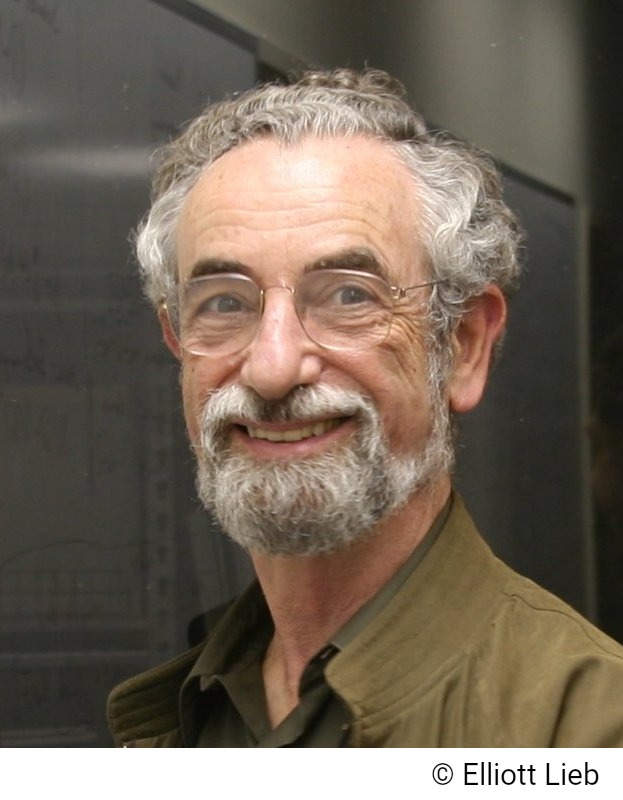Elliott Lieb

The Medal of the Erwin Schrödinger Institute for Mathematics and Physics for the year 2021 is awarded to Elliott Lieb.
The ESI medal is awarded annually for outstanding research to physics or mathematics. The 2021 laureate, Elliott H. Lieb, is eminently qualified for this honour having during a time span of almost 70 years enriched both disciplines by hundreds of seminal papers of highest quality. He held joint professorships in mathematics and physics at Princeton University from 1975 until his retirement in 2018, but the latter has not affected his scientific productivity which continues to be extraordinary.
Elliott Hershel Lieb, born in 1932, obtained his B.S. degree at the Massachusetts Institute of Technology. From 1953 until 1956 he studied at the University of Birmingham in England for his Ph.D. Back in the US he held postdoctoral appointments at the University of Illinois and at Cornell University and a permanent position at IBM. He then moved on to Yeshiva University in New York, Northeastern University in Boston and to MIT again. In 1975 he became a full Professor at Princeton University.
Here is a list of Lieb's main fields of research: models of statistical mechanics, especially exactly soluble models, many-body quantum physics, including the Bose gas and Bose-Einstein condensation, inequalities for quantum entropy, the quantum theory of Coulomb systems including density functional theory and exact results on atoms and molecules, stability of matter, matter in strong magnetic fields, harmonic maps and liquid crystals, quantum electrodynamics, the second and the third law of thermodynamics, sharp constants in fundamental inequalities of functional analysis.
According to the statutes of the ESI medal "emphasis is given to recent achievements, obtained no more than 10 years before the nomination deadline", and the prize committee singled out two highlights in the realm of Coulomb systems which were published in 2019 and 2020. These are a mathematically rigorous justification of the Local Density Approximation in Density Functional Theory, and a proof of the equivalence in the thermodynamic limit of three different definitions of the minimum energy of a homogeneous electron gas (joint work with Mathieu Lewin and Robert Seiringer).
Density functional theory is a method to analyse large systems of matter composed of electrons and nuclei. In such situations the basic Schrödinger equation has far too many variables to be soluble exactly, even not with the most powerful computers. However, it turns out that essential features of the systems, in particular its ground state properties, can often be described by far simpler equations where only the density of the electrons enters, a function of three variables, rather than the full Schrödinger wave function which may have as many as 1020 or more variables.
Density functional theory has its roots in work of Llewellyn Thomas and Enrico Fermi from the early days of quantum mechanics. Although put forward in 1927, its mathematical status as an asymptotic approximation for large atoms and molecules was only firmly established in 1976 in joint work of Lieb with Barry Simon. Thomas-Fermi theory is useful for many purposes but it is too crude an approximation to capture molecular binding. For that it would be necessary to take correlations among the electrons into account and these are not visible in Thomas-Fermi theory. This "defect" was, however, turned into a virtue in 1975 when Lieb and Walter Thirring employed it to prove that the binding energy of real matter consisting of nuclei and electrons is bounded below by a constant times the number of particles with a proportionality constant of the same order of magnitude as for a hydrogen molecule. This celebrated result is called stability of matter. Where it to fail, two macroscopic lumps of matter would explode like an atomic bomb if they were brought together.
A sophisticated extension of the ideas behind Thomas-Fermi theory was put forward by Walter Kohn and coworkers in the mid 1960's and earned Kohn a Nobel Prize for Chemistry in 1998. Various forms of such extensions have been spectacularly successful in predicting the electronic properties of atoms molecules and materials. Lieb has a long standing interest in this subject and in 1983 he published a widely cited paper where he studied mathematically a functional introduced by Mel Levy in 1979 and which is nowadays referred to as the Levy-Lieb density functional. The papers from 2019 and 2020 mentioned above concern this functional. In particular it is shown that three formulas for the correlation energy of the electrons, which a priori might lead to different results, are all equivalent. This is far from obvious because the long range of the Coulomb forces can lead to crystallization of the electron gas at low densities and also makes the system highly sensitive to boundary conditions. It required great mathematical ingenuity, as typical for all of Lieb's work, to settle these questions.
Jakob Yngvason, Vienna, 2021
Webpage(s) of Prof. Lieb:
https://web.math.princeton.edu/~lieb/
https://dof.princeton.edu/people/elliott-hershel-lieb